If I mention Rio de Janeiro, Mardi Gras, or Carnevale di Venezia, what springs to mind?
Of course—Carnivals!
Since we’re in the heart of Carnival season, I couldn’t resist diving into this colorful, vibrant topic. When I think of Rio de Janeiro, I picture Brazil's electrifying samba rhythms and dazzling, extravagant costumes. Mardi Gras in New Orleans conjures images of lavish parades infused with a rich blend of French, African, and Spanish cultural influences. And Venice? It’s all about those masks and enchanting masquerade balls.
Here in Italy, Il Carnevale is a major event, celebrated with passion and creativity in towns big and small. I love discovering off-the-beaten-path places, and my search for unique Italian Carnivals led me to the charming town of Foiano della Chiana. Known as the home of Italy’s oldest Carnevale, dating back to 1539, this small town of about 9,000 people in the province of Arezzo is famed for its elaborate papier-mâché floats and deeply rooted local traditions.
With nothing planned for Sunday and Foiano just under an hour’s drive from home, Emi and I hopped in the car to experience the festivities on their opening day. But before I take you along on our visit to Foiano, let me share with you what I found about the origins of Carnival.
A Little History
The word Carnevale comes from the Latin “carnem levare” or “carne vale”, meaning "farewell to meat," marking the last indulgence before Lent's 40-day fast. Though embraced by the Church, its origins trace back to ancient pagan festivals like Saturnalia and Bacchanalia, known for masks, feasting, and social role reversals. As Christianity spread, these pagan traditions were integrated into the Church calendar. By the Middle Ages, Carnivals were widespread across Europe, especially in Italy. Costumes let participants adopt new personas—historical, mythical, or fantastical—embracing joy, mystery, and creativity in a shared celebration.
Today, the spirit of Carnevale is as vibrant as ever, celebrated not just for the fun but for its deep cultural roots. For kids, it’s a chance to dress up as their favorite heroes, much like Halloween in North America, filling the streets with colorful costumes and playful energy. Adults, on the other hand, revel in keeping age-old traditions alive, honoring Italy's rich history with pride. In many towns and cities, the excitement is so strong that preparations for the next Carnevale begin as soon as the last confetti hits the ground.
A Season Just for Italians
For most of the year, Italy shares its breathtaking landscapes, historic cities, and vibrant culture with millions of tourists. But during Carnevale, the country feels like it belongs to the Italians. It’s one of the rare times when locals reclaim the streets, celebrating with age-old traditions and festive joy. The only exception? Venice.
The Venice Carnival draws visitors from around the world, all eager to experience its iconic masquerade balls, lavish costumes, and ornate masks (maschere). The city’s winding canals and narrow streets come alive, packed shoulder-to-shoulder with revelers, each hidden behind a mask.
But the most authentic Italian Carnival it’s Viareggio. Known for its towering, satirical papier-mâché floats, this seaside town transforms its promenade into a moving gallery of artistry and political commentary. These massive, intricately designed floats deliver biting humor, poking fun at politicians and celebrities alike.
This year’s standout? A float titled "For a Healthy and Robust Constitution," with Prime Minister Giorgia Meloni front and center. She’s portrayed with a stern expression, wearing pants reminiscent of Mussolini's style, and sporting elf-like ears. Floating above her, a "blessed" Silvio Berlusconi watches over the scene, adding another layer of satire.
Italians have a famous saying: A Carnevale ogni scherzo vale, meaning at Carnival, any joke goes! Reflecting the playful and mischievous spirit of the celebration.
To read more on Viareggio’s see Judy Witts Francini's newsletter from January 30th.
Now, let’s get back to my Hidden Gem.
What sets Foiano’s Carnival apart is the fierce competition between its four historic districts, known as cantieri (boroughs). Each cantiere spends an entire year crafting a massive, satirical float in total secrecy, often targeting political and cultural themes. These floats are true masterpieces, created by skilled artisans using traditional papier-mâché techniques passed down through generations.
As we wandered through the town’s narrow streets, the floats rolled by with barely centimeters to spare—a truly up-close spectacle. Music, laughter, and colorful confetti filled the air. Kids and adults alike stood in awe, admiring the giant floats.
Below are the four floats for this year’s Carnival of Foiano
We followed the procession up to their place of construction, just on the fringe of the town. I was surprised to see the huge warehouse where they are dismantled and rebuilt every year. I could sense how seriously they take this activity. Building such an enormous space to house the four float-making teams, along with the multiple trades and craftsmen involved, is truly a work of passion and devotion.
I could not resist asking one of the men standing near a float a few questions.
"Ciao, mi chiamo Tino. Sono qui per visitare e scrivere un articolo sul Carnevale. Mi potresti dare un piccolo minuto per condividere la tua impressione?"
(Hello, my name is Tino. I’m here to enjoy the Carnival and write an article. Could you spare a moment to share your impression?)
"Ma sicuro!" (Yes, of course!)
"What is your name, and what’s it like to be part of such a tradition?"
"I’m Luca. I’ve been involved in building the floats for years now. We pour our heart and soul into these creations. It’s not just about craftsmanship; it’s about the message we want to convey. The process starts many months before Carnival, with late nights spent painting, designing, and working together as a team. When you finally see it rolling down the street and hear the crowd’s reaction, it makes every second worth it. It feels like being part of something bigger than yourself. For a few hours, it’s not about competition—it’s about celebration, about the joy we bring to the town. It’s like everyone is united in one big dream."
And, as always in Italy, no celebration is complete without food! The streets were lined with bancarelle (stalls) offering local delicacies, including special treats unique to the carnival season. The specialty for this occasion is Ciacce fritte farcite. These light, fried flatbreads puff up beautifully and are stuffed with local specialties like prosciutto toscano, finocchiona, pecorino cheese, or seasonal vegetables. The contrast between the crunchy exterior and the warm, flavourful filling makes them an irresistible treat, best enjoyed fresh with a glass of local red wine.
The town is also famous for its high-quality Chianina beef (hence the name Foiano della Chiana). This meat is the key ingredient in Bistecca alla Fiorentina, a thick, juicy T-bone steak that is a staple of Tuscan cuisine.
In the main piazza, I approached a couple dressed in lively costumes with vibrant colors. I told them I was visiting from out of town and was planning to write an article.
"Would you mind telling me what makes Carnival in Foiano so special for you?"
"Ah, this Carnival—it’s in my blood!" the girl said. "I’ve been coming here since I was very little. There’s something magical about it—seeing the whole town come together, no matter how much the world changes. People from all walks of life take part in this celebration. It feels like a big family reunion, even for those who live far away. And, of course, the floats are spectacular—each one tells a story, makes you laugh, or sometimes even makes you think.
And there’s always a bit of humor, a little sarcasm in those floats. It’s the Italian way of looking at life—you know, making fun of ourselves, the world, and all its madness."
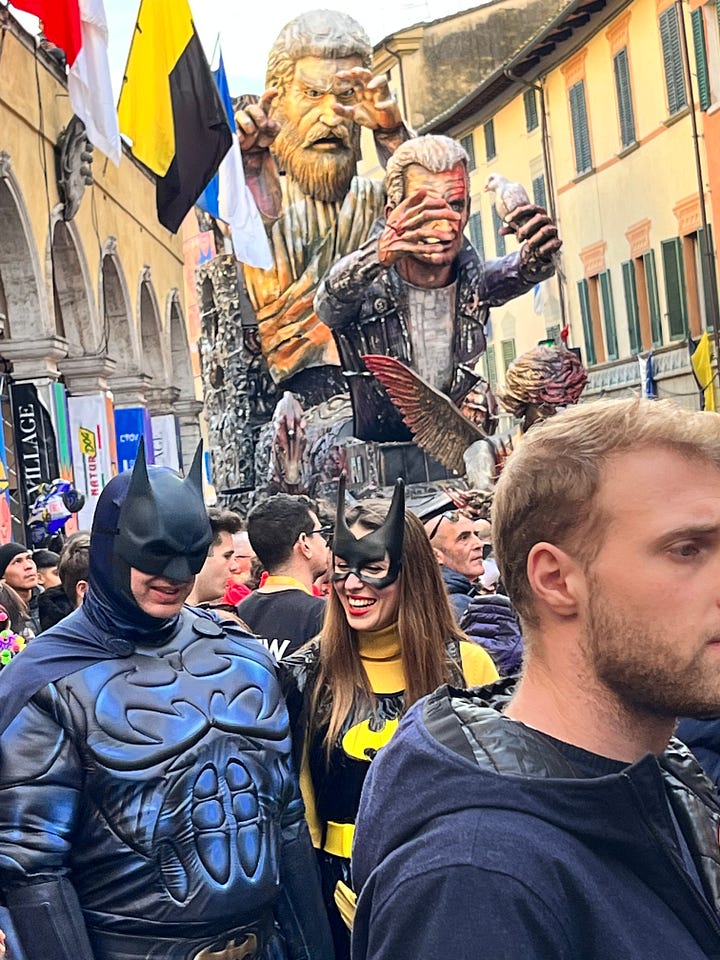
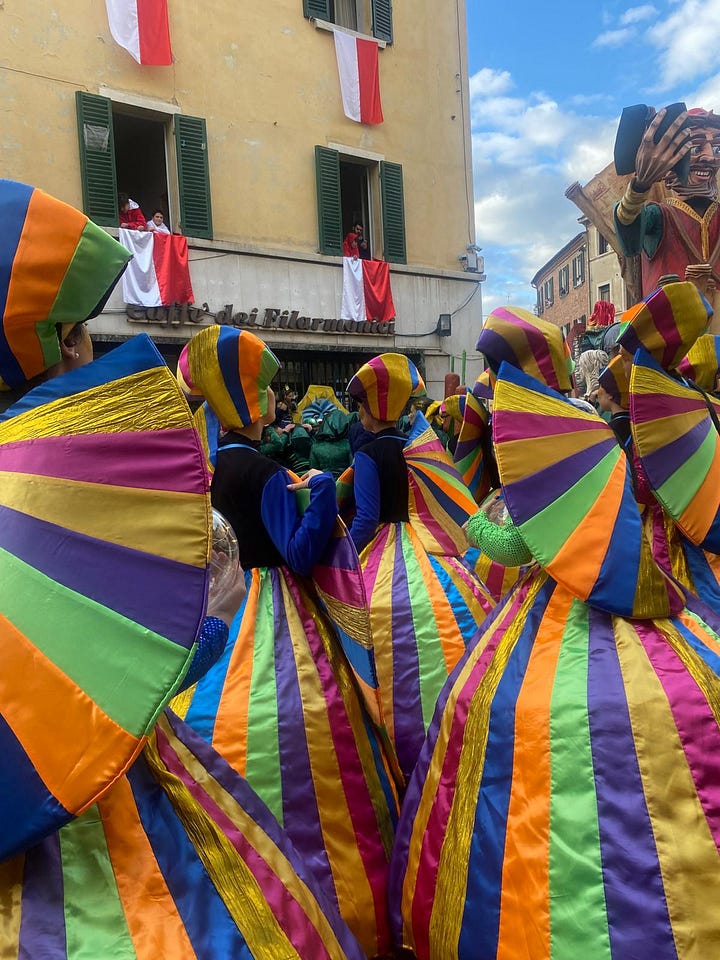

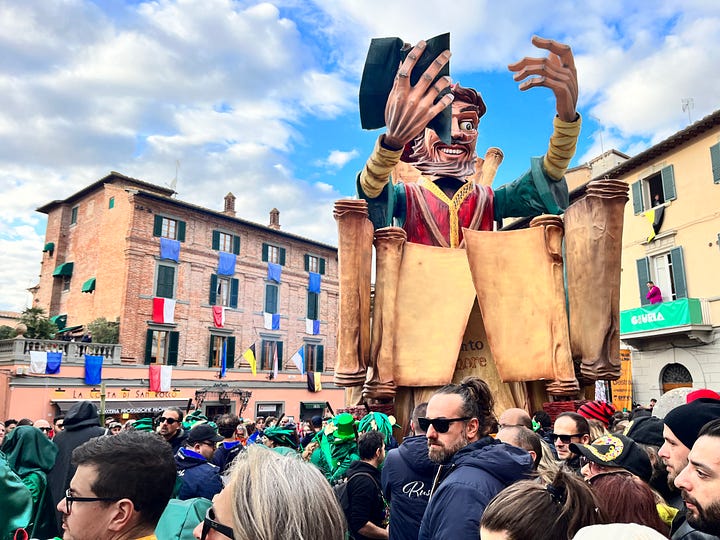
Coffee bars and shops were packed as we finally found two outdoor seats at Pasticceria La Costa di San Rocco. Our drink of the day was Crodino, a non-alcoholic aperitif. I had mine on ice, while Emi preferred hers with just a slice of orange. A Crodino is made from a blend of herbs, spices, and citrus extracts, similar to traditional bitter aperitifs like Campari but without the alcohol. As the sun faded and the evening chill filled the piazza, the music grew louder, and the festive atmosphere carried on.
What I loved most about this afternoon was discovering a world-class celebration in a small, off-the-beaten-path town. That’s the magic of Italy—you never know when you’ll stumble upon your next hidden gem.




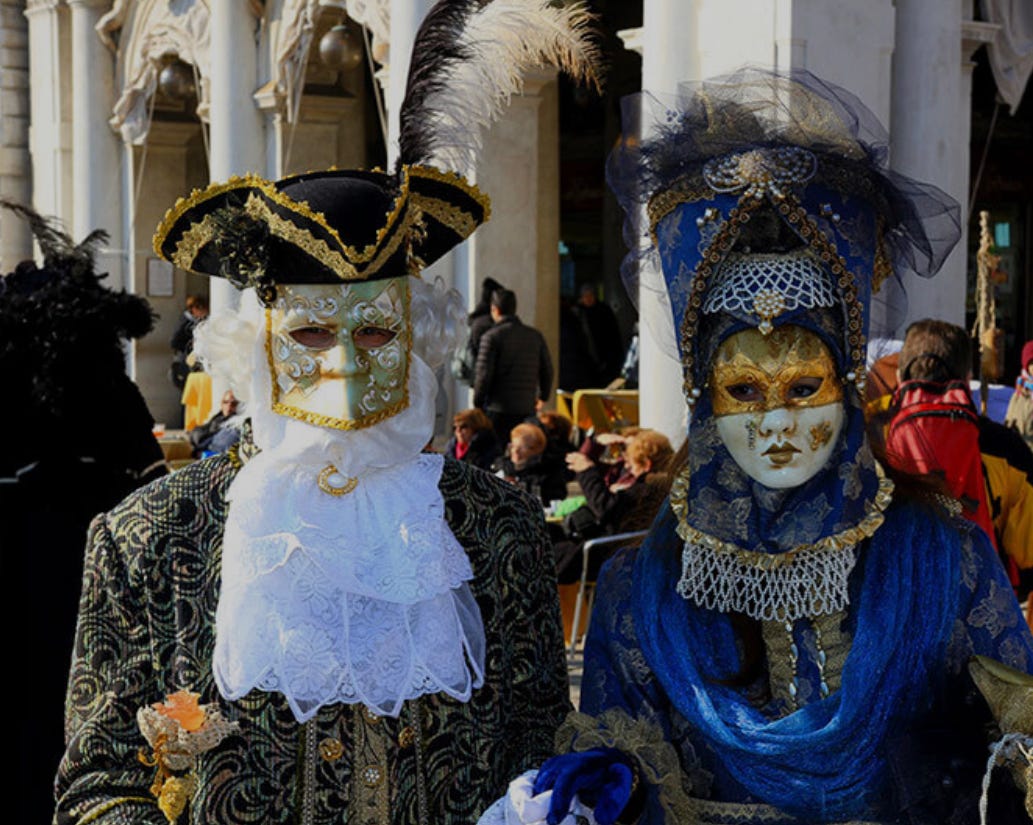
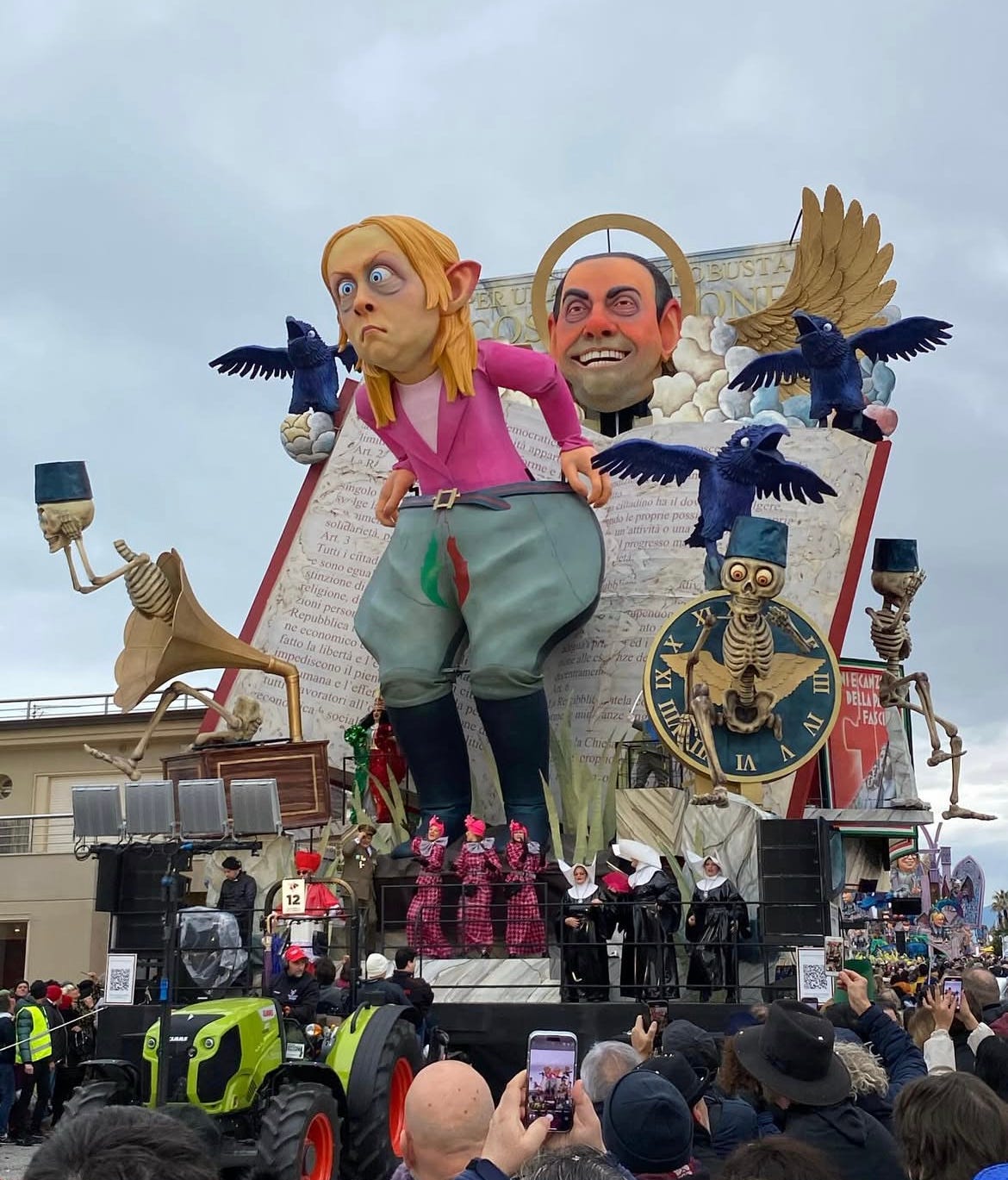
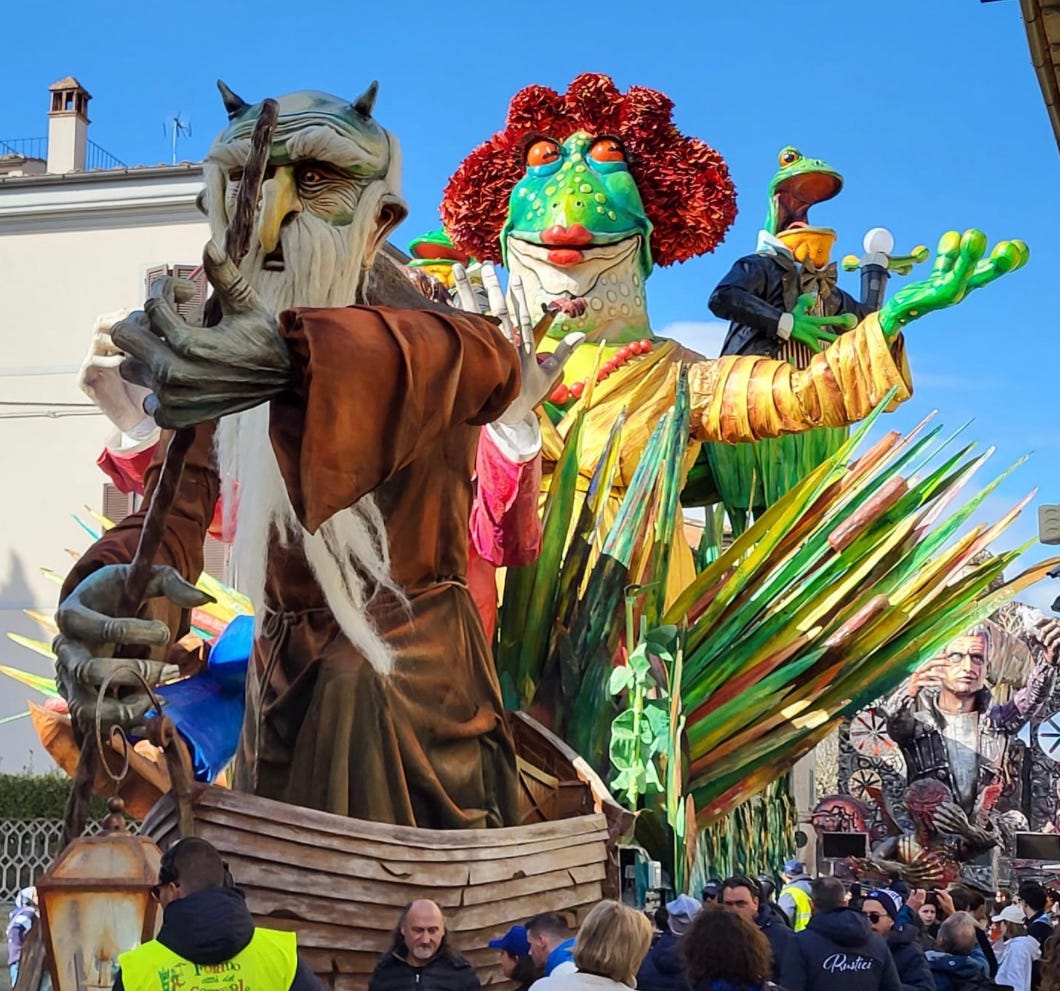
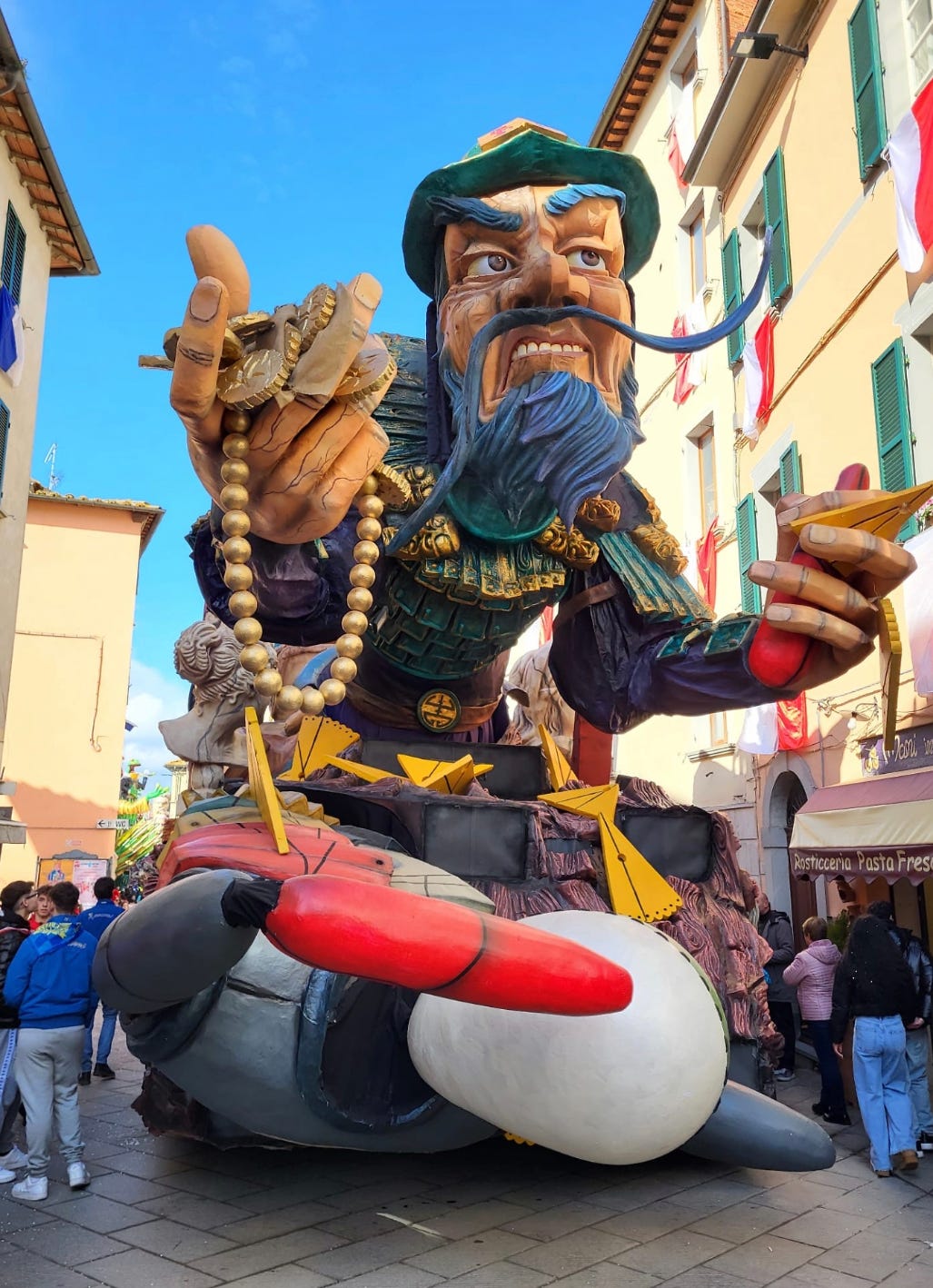

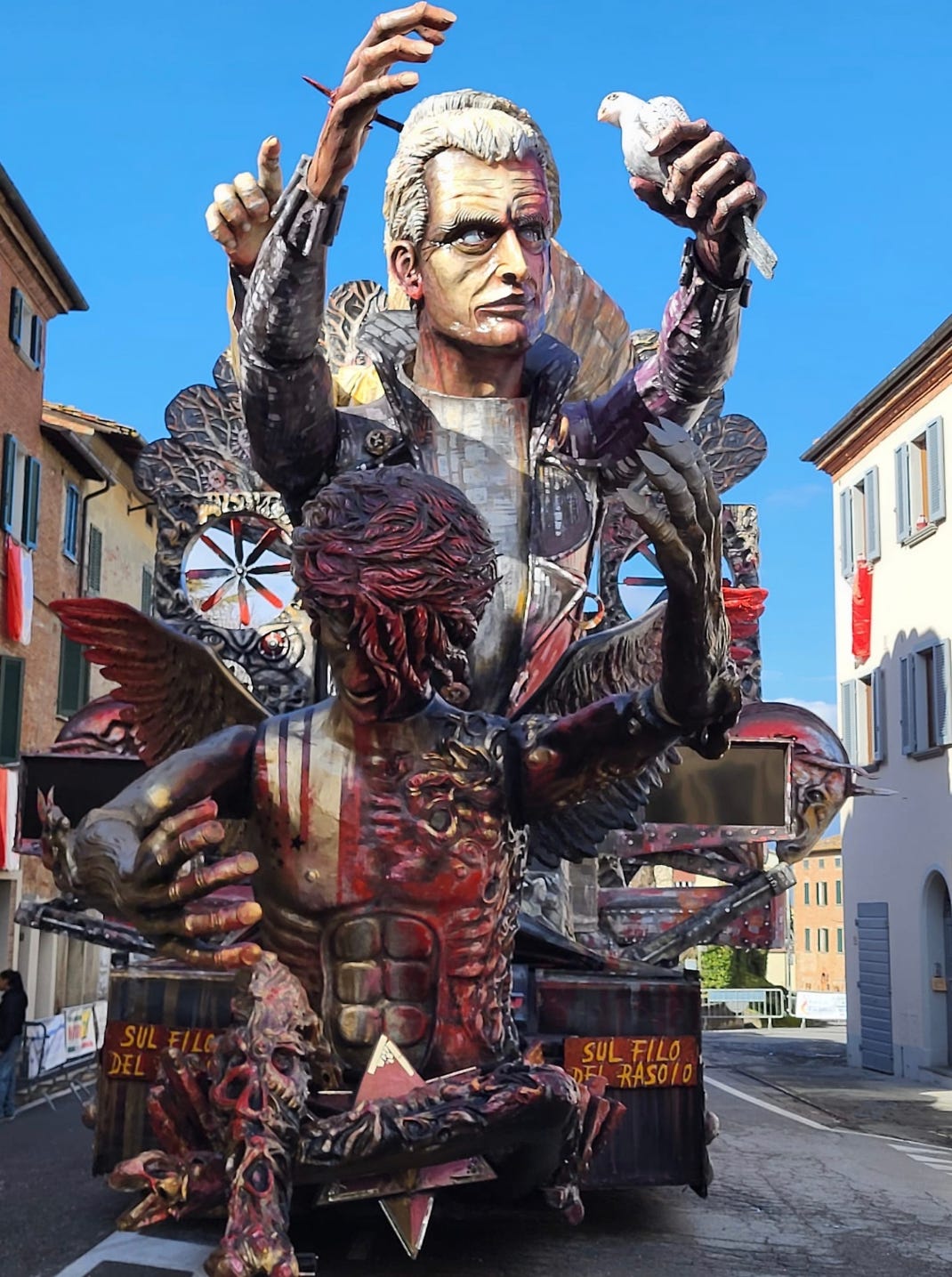
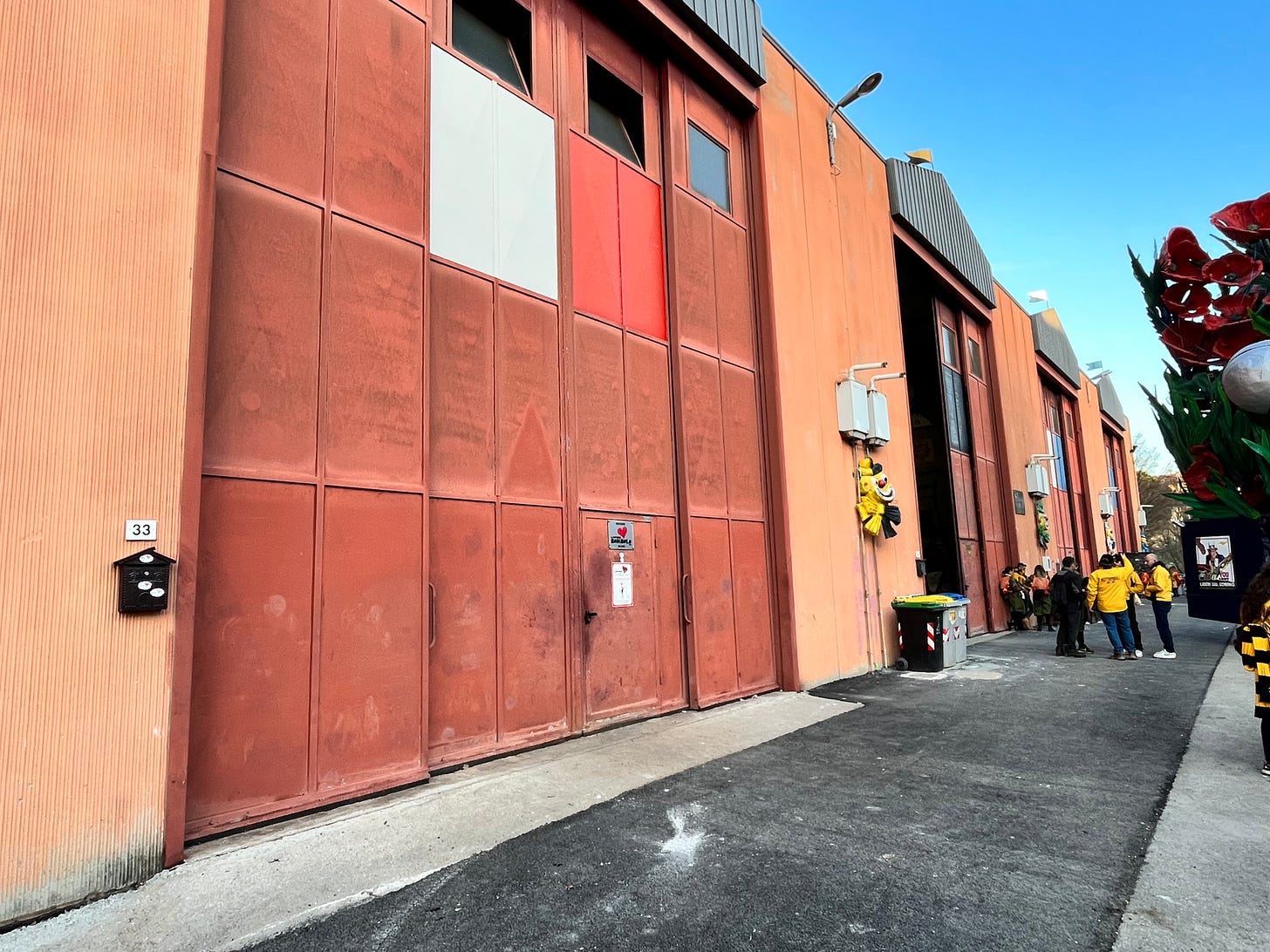



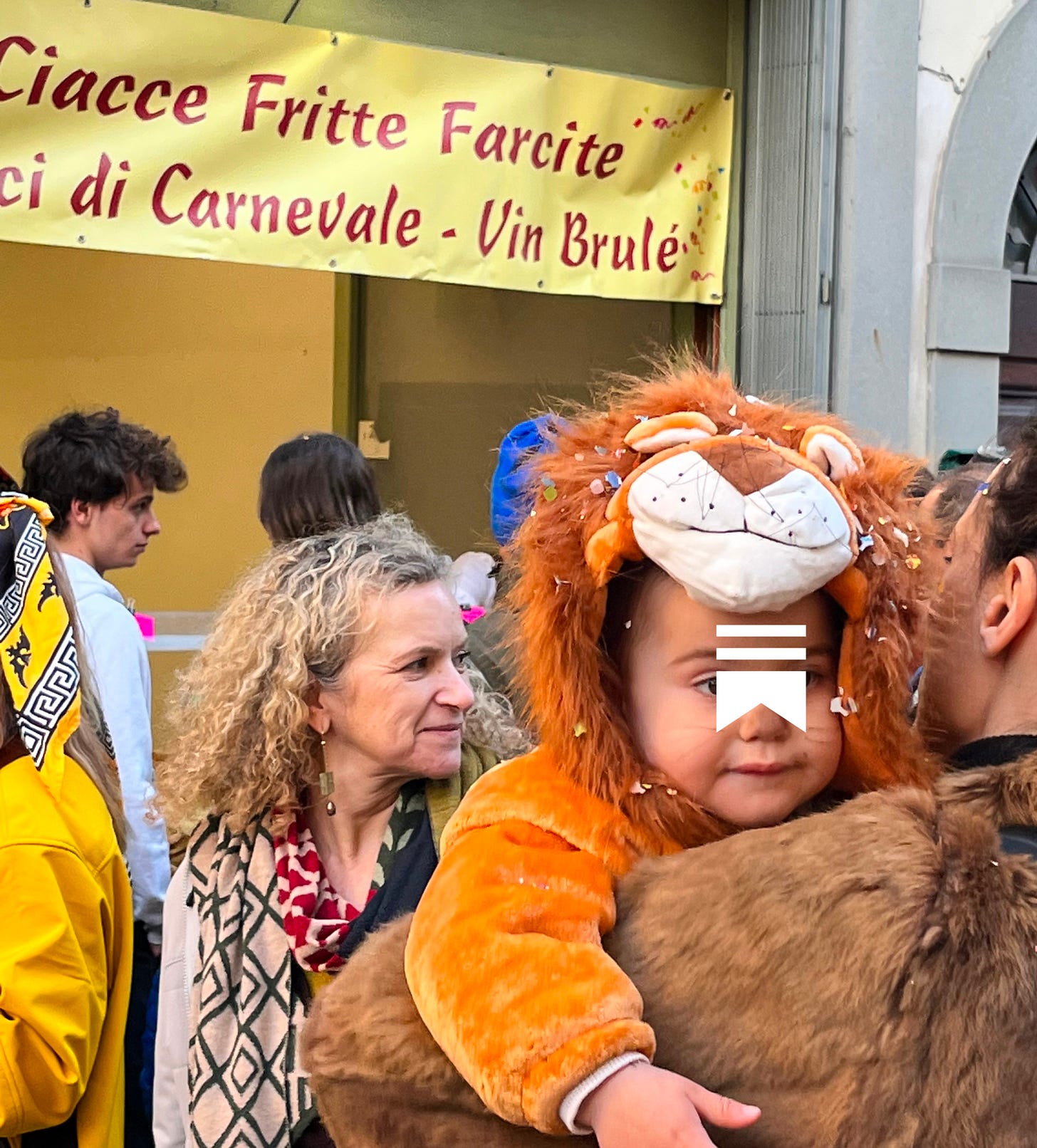

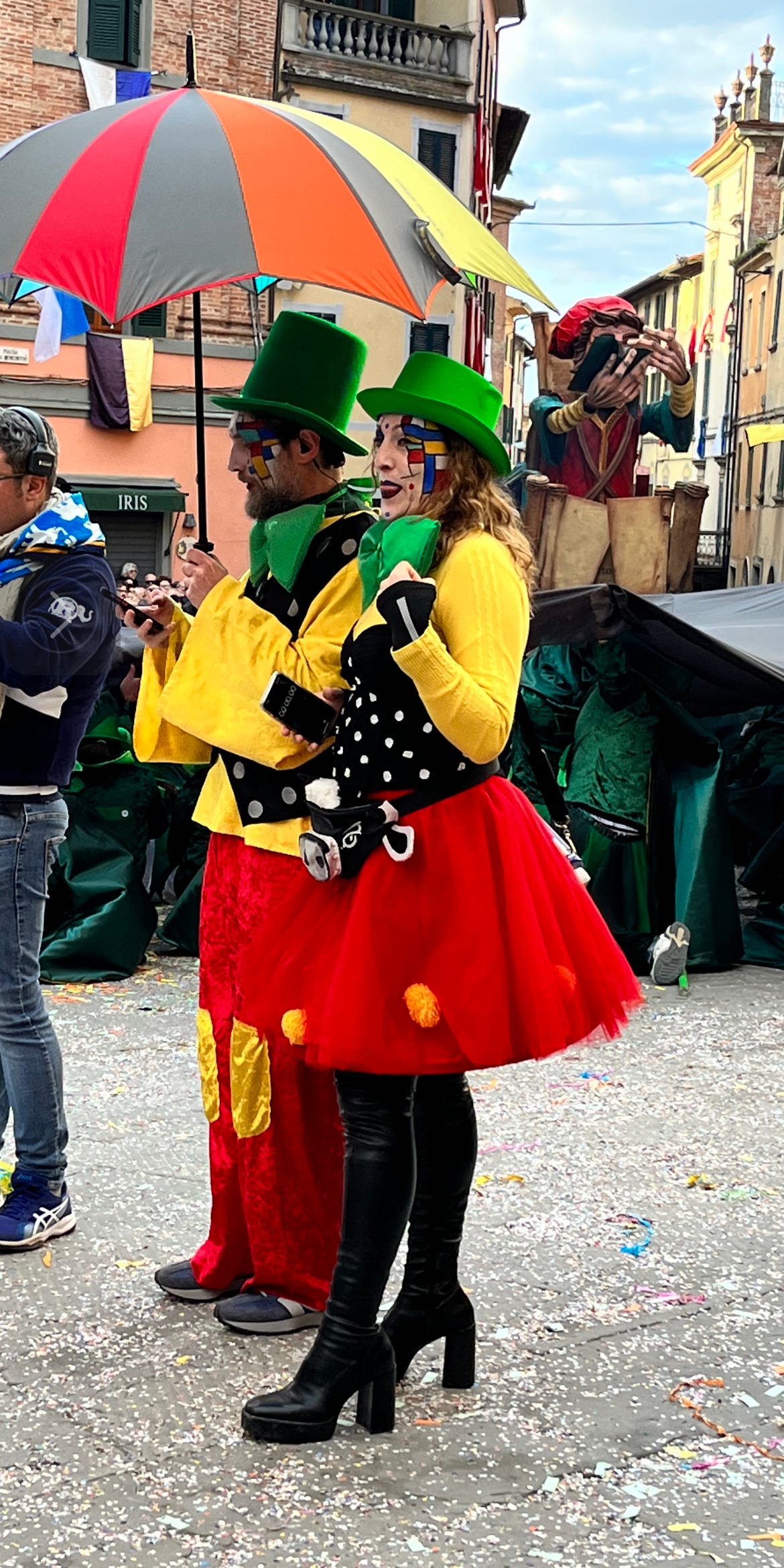


We have a carnival coming up in Ontario. It is called a Provincial Election 😊. Unfortunately the costumes are not as elaborate and the street food is not as good. Tino, you always find something truly interesting to write about. The artistry and engineering of the floats is impressive. Imagine how interested I am in your adventures, I read you even before I do Wordle!!
Thank you, Tino, for reviving the magic of Carnavale. The stories and hidden gems you shared made for a captivating read, but more importantly, they deepened my understanding of its origins. Your insights brought this vibrant tradition to life, allowing us to experience its essence from afar. Grateful for yet another enriching journey through your words. Ps: great pictures of the floats!